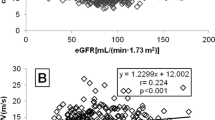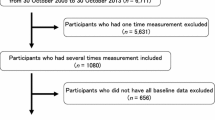Abstract
Introduction
The association between hyperuricemia and cardiovascular disease in hypertensive subjects is controversial. Attempts to elucidate the possible association between hyperuricemia and early atherosclerosis in hypertensive patients may provide alternative prevention or therapy targets for future cardiovascular events.
Methods
A total of 67 hypertensive and 30 healthy subjects underwent B-mode ultrasonography to measure carotid intima media thickness (C-IMT). All biochemical analyses were assessed by local laboratories using standard laboratory methods.
Results
C-IMT, serum uric acid (UA) levels, and mean arterial blood pressure (MBP) levels were significantly higher in hypertensive population compared to healthy subjects (P<0.001). Among hypertensive subjects, high sensitivity C-reactive protein (hs-CRP), C-IMT, and proteinuria levels were significantly higher in hyperuricemic patients compared to normouricemic participants (for all, P<0.05). Age (r=0.28, P=0.02), MBP (r=0.34, P=0.04), hs-CRP (r=0.58, P=0.006), proteinuria (r=0.58, P=0.007), estimated glomerular filtration rate (r=−0.35, P=0.02), and UA (r=0.31, P=0.02) levels were significantly associated with C-IMT levels. Multiple linear regression analysis using C-IMT as a dependent variable showed that age (beta=0.84, P=0.03) and UA levels (beta=−0.87, P=0.02) were independently associated with C-IMT.
Conclusion
Hyperuricemia is an independent predictor for early atherosclerosis in hypertensive subjects with normal renal function. Therefore, the optimal control of UA may provide further benefits in preventing atherosclerosis and hypertensive end-organ injury.
Similar content being viewed by others
References
Mancia G, Laurent S, Agabiti-Rosei E, et al. Reappraisal of European guidelines on hypertension management: a European Society of Hypertension Task Force document. Blood Press. 2009;18:308–347.
Vasan RS, Larson MG, Leip EP, et al. Impact of high-normal blood pressure on the risk of cardiovascular disease. N Eng J Med. 2001;345:1291–1297.
Kshirsagar AV, Carpenter M, Bang H, et al. Blood pressure usually considered normal is associated with an elevated risk of cardiovascular disease. Am J Med. 2006;119:133–141.
Zanchetti A, Hennig M, Hollweck R, et al. Baseline values but not treatment-induced changes in carotid intima-media thickness predict incident cardiovascular events in treated hypertensive patients: findings in the European Lacidipine Study on Atherosclerosis (ELSA). Circulation. 2009;120:1084–1090.
Sehestedt T, Jeppesen J, Hansen TW, et al. Which markers of subclinical organ damage to measure in individuals with high normal blood pressure? J Hypertens. 2009;27:1165–1171.
Hurst RT, Ng DW, Kendall C, et al. Clinical use of carotid intima-media thickness: review of the literature. J Am Soc Echocardiogr. 2007;20:907–914.
So A, Thorens B. Uric acid transport and disease. J Clin Invest. 2010;120:1791–1799.
Bagnati M, Perugini C, Cau C, et al. When and why a water-soluble antioxidant becomes pro-oxidant during copper-induced low-density lipoprotein oxidation: a study using uric acid. Biochem J. 1999;340:143–152.
Khosla UM, Zharikov S, Finch JL, et al. Hyperuricemia induces endothelial dysfunction. Kidney Int. 2005;67:1739–1742.
Hotamisligil GS. Inflammation and metabolic disorders. Nature. 2006;444:860–867.
De Luca G, Secco GG, Santagostino M, et al. Uric acid does not affect the prevalence and extent of coronary artery disease. Results from a prospective study. Nutr Metab Cardiovasc Dis. 2010; [Epub ahead of print].
Culleton BF, Larson MG, Kannel WB, et al. Serum uric acid and risk for cardiovascular disease and death: the Framingham Heart Study. Ann Intern Med. 1999;131:7–13.
Chobanian AV, Bakris GL, Black HR, et al. The Seventh Report of the Joint National Committee on Prevention, Detection, Evaluation, and Treatment of High Blood Pressure: the JNC 7 report. JAMA. 2003;289:2560–2572.
Pearson TA, Blair SN, Daniels SR, et al. AHA Guidelines for Primary Prevention of Cardiovascular Disease and Stroke: 2002 Update: Consensus Panel Guide to Comprehensive Risk Reduction for Adult Patients Without Coronary or Other Atherosclerotic Vascular Diseases. American Heart Association Science Advisory and Coordinating Committee. Circulation. 2002;106:388–391.
Tavil Y, Kaya MG, Oktar SO, et al. Uric acid level and its association with carotid intimamedia thickness in patients with hypertension. Atherosclerosis. 2008;197:159–163.
Neogi T, Ellison RC, Hunt S, et al. Serum uric acid is associated with carotid plaques: the National Heart, Lung, and Blood Institute Family Heart Study. J Rheumatol. 2009;36:378–384.
Fang J, Alderman MH. Serum uric acid and cardiovascular mortality the NHANES I epidemiologic follow-up study, 1971–1992. National Health and Nutrition Examination Survey. JAMA. 2000;283:2404–2410.
Liese AD, Hense HW, Lowel H, et al. Association of serum uric acid with all-cause and cardiovascular disease mortality and incident myocardial infarction in the MONICA Augsburg cohort. World Health Organization Monitoring Trends and Determinants in Cardiovascular Diseases. Epidemiology. 1999;10:391–397.
1999 World Health Organization — International Society of Hypertension Guidelines for the Management of Hypertension. Guidelines Subcommittee. J Hypertens. 1999;17:151–183.
Zheng L, Sun Z, Li J, et al. Pulse pressure and mean arterial pressure in relation to ischemic stroke among patients with uncontrolled hypertension in rural areas of China. Stroke. 2008;39:1932–1937.
Friedewald WT, Levy RI, Fredrickson DS. Estimation of the concentration of low-density lipoprotein cholesterol in plasma, without use of the preparative ultracentrifuge. Clin Chem. 1972;18:499–502.
Levey AS, Bosch JP, Lewis JB, et al. A more accurate method to estimate glomerular filtration rate from serum creatinine: a new prediction equation. Modification of Diet in Renal Disease Study Group. Ann Intern Med. 1999;130:461–470.
Ruilope LM, Garcia-Puig J. Hyperuricemia and renal function. Curr Hypertens Rep. 2001;3:197–202.
Bilginer Y, Ozaltin F, Basaran C, et al. Evaluation of intima media thickness of the common and internal carotid arteries with inflammatory markers in familial Mediterranean fever as possible predictors for atherosclerosis. Rheumatol Int. 2008;28:1211–1216.
Armentano R, Megnien JL, Simon A, et al. Effects of hypertension on viscoelasticity of carotid and femoral arteries in humans. Hypertension. 1995;26:48–54.
McEniery CM, Wilkinson IB, Avolio AP. Age, hypertension and arterial function. Clin Exp Pharmacol Physiol. 2007;34:665–671.
Haig A. On Uric Acid and Arterial Tension. Br Med J. 1889;1:288–291.
Taniguchi Y, Hayashi T, Tsumura K, et al. Serum uric acid and the risk for hypertension and Type 2 diabetes in Japanese men: The Osaka Health Survey. J Hypertens. 2001;19:1209–1215.
Grayson PC, Kim SY, LaValley M, et al. Hyperuricemia and incident hypertension: a systematic review and meta-analysis. Arthritis Care Res (Hoboken). 2011;63:102–110.
Nagahama K, Inoue T, Iseki K, et al. Hyperuricemia as a predictor of hypertension in a screened cohort in Okinawa, Japan. Hypertens Res. 2004;27:835–841.
Mellen PB, Bleyer AJ, Erlinger TP, et al. Serum uric acid predicts incident hypertension in a biethnic cohort: the atherosclerosis risk in communities study. Hypertension. 2006;48:1037–1042.
Mazzali M, Kanbay M, Segal MS, et al. Uric acid and hypertension: cause or effect? Curr Rheumatol Rep. 2010;12:108–117.
Kanbay M, Ozkara A, Selcoki Y, et al. Effect of treatment of hyperuricemia with allopurinol on blood pressure, creatinine clearence, and proteinuria in patients with normal renal functions. Int Urol Nephrol. 2007;39:1227–1233.
Mikuls TR, Farrar JT, Bilker WB, et al. Gout epidemiology: results from the UK General Practice Research Database, 1990–1999. Ann Rheum Dis. 2005;64:267–272.
Leite ML. Uric acid and fibrinogen: age-modulated relationships with blood pressure components. J Hum Hypertens. 2011;25:476–483.
Riegersperger M, Covic A, Goldsmith D. Allopurinol, uric acid, and oxidative stress in cardiorenal disease. Int Urol Nephrol. 2011;43:441–449.
Moriarity JT, Folsom AR, Iribarren C, et al. Serum uric acid and risk of coronary heart disease: Atherosclerosis Risk in Communities (ARIC) Study. Ann Epidemiol. 2000;10:136–143.
Choi HK, Ford ES, Li C, et al. Prevalence of the metabolic syndrome in patients with gout: the Third National Health and Nutrition Examination Survey. Arthritis Rheum. 2007;57:109–115.
Montalcini T, Gorgone G, Gazzaruso C, et al. Relation between serum uric acid and carotid intima-media thickness in healthy postmenopausal women. Intern Emerg Med. 2007;2:19–23.
Kawamoto R, Tomita H, Oka Y, et al. Association between uric acid and carotid atherosclerosis in elderly persons. Int Med. 2005;44:787–793.
Kang DH, Han L, Ouyang X, et al. Uric acid causes vascular smooth muscle cell proliferation by entering cells via a functional urate transporter. Am J Nephrol. 2005;25:425–433.
Johnson RJ, Kang DH, Feig D, et al. Is there a pathogenetic role for uric acid in hypertension and cardiovascular and renal disease? Hypertension. 2003;41:1183–1190.
Tsukimori K, Yoshitomi T, Morokuma S, et al. Serum uric acid levels correlate with plasma hydrogen peroxide and protein carbonyl levels in preeclampsia. Am J Hypertens. 2008;21:1343–1346.
Author information
Authors and Affiliations
Corresponding author
Rights and permissions
About this article
Cite this article
Mutluay, R., Deger, S.M., Bahadir, E. et al. Uric Acid is an Important Predictor for Hypertensive Early Atherosclerosis. Adv Therapy 29, 276–286 (2012). https://doi.org/10.1007/s12325-012-0006-z
Received:
Published:
Issue Date:
DOI: https://doi.org/10.1007/s12325-012-0006-z




